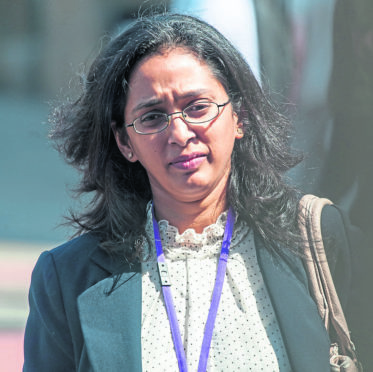A senior gynaecologist accused of causing an unborn baby to be accidentally decapitated has broken down in tears as she claimed she may have tried “too hard” to complete a successful delivery.
Dr Vaishnavy Laxman, 43, who was nearing the end of a 24-hour shift at Ninewells Hospital in Dundee, should have given her patient an emergency Caesarean section as the premature infant was in a breech position, a tribunal has heard.
Tragedy struck when the doctor urged the patient to push while herself applying traction to the baby’s legs. The manoeuvre caused the infant’s legs, arms and torso to become detached leaving the head still in his mother’s womb.
Two other doctors subsequently carried out a C-section on the woman to remove the infant’s head. It was ‘’re-attached’’ to his body so his mother could hold him before she said goodbye. It is alleged the mother was not even in established labour at the time.
At the Medical Practitioners Tribunal Service in Manchester, Dr Laxman wept as she relived what had happened on March 16, 2014.
She told the panel the baby would have died had a C-section been carried out.
She said: “I was trying to deliver a live baby, I was trying really hard, possibly too hard.
“I did not intend to harm mum or the baby. I am distraught at the outcome and I am very sorry it did not come out the way I meant it.”
The 30-year-old patient’s waters had broken early at 25 weeks and upon examination her unborn baby was found to have a prolapsed cord and was in a breech position, while the mother’s cervix was around 2-3cm dilated. It can be 10cm fully dilated.
Dr Laxman – who had started work at 8.30am the previous day – was told about the patient at 2am and later paged to take a look at her when her condition became more critical at 8.30am.
The doctor told the tribunal: “I thought with a C-section we might not have a live baby and it would have been a difficult procedure.
“The bottom of the baby came out quite easily and when this happened I thought it was going to be possible. I started to encourage the patient to push.
“After two to three pushes the baby’s bottom had been delivered all the way up to its chest. After that there was some difficulty in delivering the arms. The arms were behind the baby’s neck. I tried a manoeuvre to release the arms. I lifted the baby’s head and rotated the body 90 degrees to tether the arm and then rotated 180 degrees to tether the other arm.”
The doctor said she managed to get the arms free and went to deliver the baby’s head, but could feel the cervix closing around it. She cut the cervix, but it had no impact and with the mother in pain, she was given general anaesthetic.
She added: “We made another cut to the cervix and I used my index finger to flex the baby’s head to deliver the baby using traction. But at some point between the general anaesthetic and the decapitation, the baby died – I’m not sure when.”
Under cross-examination, Dr Laxman said she had delivered lots of babies, including some in breech, some with prolapsed cords and some premature – but never “everything with one patient” before.
She added: “I wanted to do what was best for Patient A and the baby, and give the baby the best possible chance of survival. The C-section would have been technically difficult and we didn’t have much time.
“I agree I should not have persisted with my hands over the period of time when I knew the head was stuck with head entrapment. I wish that I stopped at some point before the decapitation could happen.”
Dr Laxman denies misconduct. The hearing continues.
